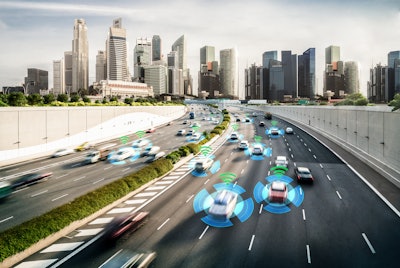
Safety is both a moral imperative and economic problem for fleets around the world. Motor vehicle fatalities were up 24% last year with over 1.35 million people killed. Crash injuries are also a major cause of death. All of this is tragic and costly to the industry. Insurance costs have increased 10-15% for the last 3 years and now account for 7.5% of a company’s revenue. On a worldwide scale vehicle crash injuries cost nearly $2 trillion. Yet the vast majority of these devastating events are avoidable.What can be done?
Transportation planners, local officials and the public are actively looking at solutions to our increased reliance on commercial freight vehicles for last mile delivery. Which is known to be the most costly and inefficient portion of the supply chain due to their frequent starts and stops on busy roads.
This is the perfect storm of ballooning operational costs, driver churn and increased demand. Now more than ever commercial fleets stand to benefit from a compelling safety solution. Carriers that take driver and road safety seriously cannot afford to wait for future infrastructure investment to make roads safer for all users.
Many are taking action now with AI-powered safety solutions to address this critical problem, mitigate risk and respond to public pressure. Knowing the right questions to ask at the outset will help buyers ensure that they invest in a vehicle safety technology with highly advanced early warning capabilities that provide drivers with the critical extra seconds they need to help prevent collisions while preserving a satisfactory driving experience with very low false positive rates and protection of privacy.
Here are 7 critical questions that fleet safety, ops and risk teams need to ask as they consider AI-based vehicle safety systems if they are serious about trying to improve vehicle safety.
- Does the AI system offer real time alerts?
An ideal solution should offer real time alerts to enable drivers to react and help avoid collisions and self-correct. A system that analyzes data and video after the fact does not create immediate impact. Think about the comprehensiveness of the solution. Does it detect both external and internal risks? More importantly the risk increases when there is a combination of factors present. A drowsy driver using a cellphone is at a greater risk of striking a pedestrian than an attentive driver who is focused on the road. Does your safety system understand the increased risk due to multiple variables and provide the alerts accordingly?
- What risk factors are covered?
Knowing the risk factors that the solution can address and the level of relevance for your fleet is critical. Are they the most statistically likely to occur and cause a collision? The Virginia Tech Transportation Institute has published several studies about transportation and safety. One recent webinar covered driving behaviors and their prevalence rate under normal driving conditions and the odds ratio that an incident occurs while the behavior is happening. The value prop of AI-based systems is clear: traditional telematics focus on aggressive driving behaviors acceleration, braking, cornering and high G events which only account for 19% of collision risk factors. These indications can be incorrect or a secondary proxy for true sources of risk. Certain AI powered systems can cover more than 90% of known risk factors. Including when one or more risk factors are present at the same time. This means that your safety system can be more impactful.
- How accurate is it?
Accuracy and precision of the safety system should be an important criterion for you to select a safety system for your fleet. It matters because incorrectly alerting, missing alerts or over alerting is detrimental to your safety program. While commercially available systems cannot be 100% accurate, you should look for a system that is highly accurate and begins to immediately build trust with the driver. Too many false positives are problematic because drivers will ignore the warnings, also known as alert fatigue. Drivers will forgo the opportunity to adjust their behavior because of this. It can lead to distrust of management and undermine the good incentives of fleet bonus programs designed to reward good driving performance.
- Is the system robust?
There is compelling data that shows the vast majority of collisions occur at 1G or lower. More advanced camera and detection systems are capable of capturing low-g collisions by applying AI to analyze a confluence of factors and not simply g-force. Make sure that the system can adapt to all sizes and types of fleet vehicle sizes and work in cities, towns and remote rural outposts. You should verify that systems operate reliably at night and don’t get confused if drivers wear sunglasses, masks, or hats.
- Is it driver friendly?
Traditional approaches often leave driver concerns as secondary. Best in class solutions take a driver centric approach and allow fleet managers to determine which alerts and configurations they want. They also include a number of driver centric options for feedback like providing real time alerts to drivers without showing the event to a manager and having the option to turn off audio and video recording or only uploading high risk and high frequency events to managers to preserve driver privacy.
6. What support exists for fleet managers?
Many AI-based fleet safety systems offer a version of a driver scorecard system. Some also offer an enterprise fleet application that runs in the cloud for use by safety and fleet managers, legal and risk officers include tools to score coach drivers, report and process claims, manage fleets and drivers, understand and report on trips and maps. Look for comprehensiveness of the scoring system - does it cover all the important risk factors that cause collisions? Does it also offer scorecards for manager effectiveness? Do those scorecards focus on measurable results and improvements vs. simply recording activities?
Coaching is another consideration. When selecting a provider ensure that the coaching tools provided fit well with your current processes and a mobile app version exists. Most AI solutions implement coaching models that look for patterns of risky behavior. An emerging area is called driver self-coaching. This relies on a driver app where drivers review their own events and receive feedback from the safety system automatically.
- What is the ROI?
A best-in-class vehicle safety system can rapidly return value in just weeks. From collision reduction, automatic driver performance improvement, and driver exoneration to expedited claims processing. There are real world examples of Claims Operations being notified within 15 minutes of an event and accessing the footage and FNOL and sending requisite files to their insurers who closed claims within hours versus days/weeks.
What is rapid payback? Gold-standard AI systems can deliver a 70-90% reduction in distraction events in a matter of only 2 weeks after turning on alerts and a 40-80% reduction in collision frequency and losses. You should look for a system that provides a payback in months not years.



















